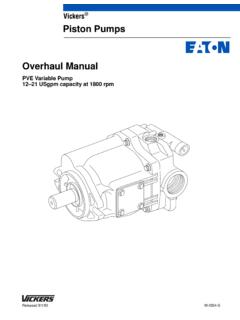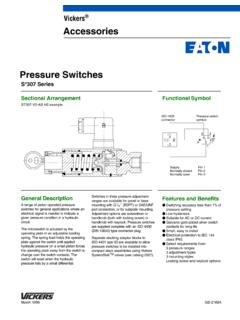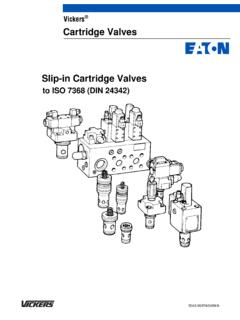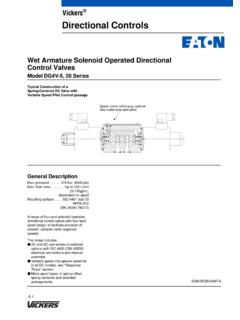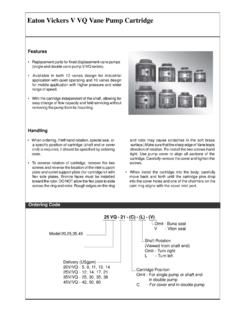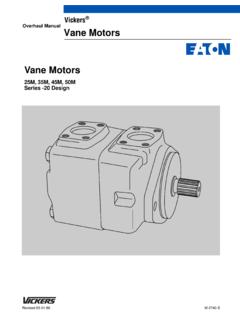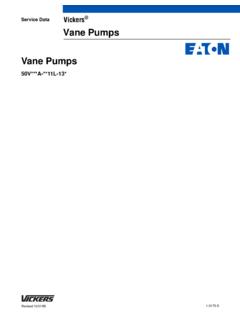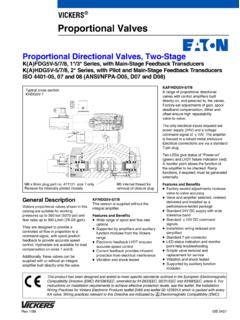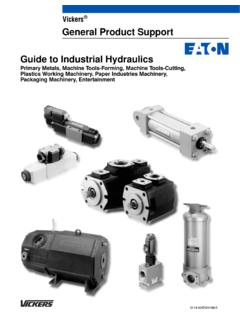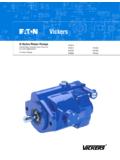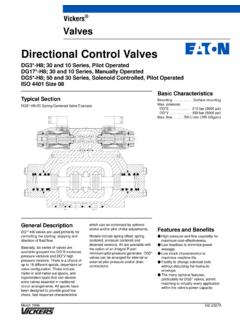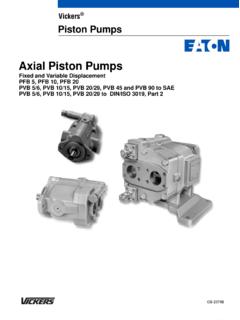Transcription of VICKERS Proportional Valves Adjustment Procedure
1 631 Released 6/9330 Design Proportional Valve AmplifierAdjustment ProcedureVICKERS Proportional Valves2 GeneralThis document describes how to set upthe VICKERS 30 design Proportional valvepower Eurocard type amplifiers covered inthis Procedure are listed below. Moredetailed information on the poweramplifiers can be found in Vickerscatalog K*G4V-3/5 Non-feedback valvesEEA-PAM-533/535-A-30 KFG4V-3/5 EEA-PAM-561-A-30 KFDG5V-5/7 EEA-PAM-568-A-30 KFDG5V-8 EEA-PAM-581-A-30 KHDG5V-5/7/8 This Procedure may also be applied tothe EEA-PAM-5**-C-30 and partially tothe EEA-PAM-5**-B-30. Refer to Vickerscatalog GB-C-2007C for more detailedinformation on these power is an easy-to-use Procedure foranyone with a little understanding ofhow Proportional Valves valve solenoids are currentcontrolled.
2 This current is usuallyregulated by varying the commandvoltage into the amplifier. The greaterthe current to the solenoid coil, thegreater will be the valve spooldisplacement (travel) and oil flowthrough the valve. By controlling the rateof current increase or decrease, thespool displacement or valve openingrate will increase or decrease resultingin acceleration or deceleration control ofthe hydraulic actuator and its document does not deal with valvesizing. However, it should be recognizedthat proper sizing will directly affect thecontrol of acceleration and the smallest valve size possibleand the smallest spool size within thatvalve size.
3 This results in pressure dropthrough the valve that exceeds levelstraditionally experienced with on-offsolenoid Valves . Smooth speed changetransitions are obtained as compared tothe high shock with on-off solenoidvalves. A single Proportional solenoidvalve can replace several conventionalvalves in a control system. Decelerationvalve, acceleration valve, flow controlsand solenoid switching valve functionsare all packaged in one proportionalvalve envelope. Smaller manifolds andfewer hydraulic interconnecting lines areneeded. Remote electric, programmablesignals to the amplifier controls all of theabove Circuit and ConnectionsA typical circuit for a single stagefeedback type valve in an open (outer)loop application is shown in Figure 1.
4 A24 VDC power supply is connected topins bdz32 (+) and bdz30 ( ). An enableswitch connected between bdz32 andpin z2a is required. The valve isconnected according to the circuitdiagram. A (+) or ( ) 10V at 5mAreference is provided for commandvoltage control. When wired as shown inthe diagram, the control pots should be2000 ohms or greater. If the pot is to beconnected across the (+) or ( ) pins z2and b2, the minimum pot size should be4000 and Connections24V DCpowersupplyClose to enableDrive enabledDrive signal zero indicatorRamp active indicatorCurrent feedbackPower amplifierbdz32bdz30z24b20b12z26z28bdz30b 26b28z18b16 b14 b22z22 15 +15 LVDT failureb18 Command signalmonitor pointsFeedbackmoduleCompensatornetworkEn abledABABP oweramplifierz2+10V x 5 mA+10V x 5 mAb2z6b6b8b10z8z10bz4 Signal 0Vb24 GainRampsDead.
5 See table belowClose +24 VOverloaddetection 15V+15V 15V 10V+10 VPWMPWMS olenoidcurrentCurrentfeedbackLVDT positionmonitor pointsNote: Connect all shieldsat card end only. On front panel To solenoid adjacent to LVDTC ommand Signals and OutputsCommand Signal TypeInput Pins ReferenceSignal PolaritySecondary Pins ReferenceValve FlowNon-inverting volt gesb6/8/10 or z8+P BNon-inverting voltagesb6/8/10 or z8 bz4P ANon-inverting c rrentz6+bz4P BNon-inverting currentz6 P AInverting volt ge Link (connect) one ofP BInverting voltagez10+Link (connect) one ofb6/8/10 or z8 to bz4P Az10 One ofP BDifferenti l volt ge+One ofb6/8/10 or z8P ADifferential voltageOne of b6/8/10 or z8+z10P BOne of b6/8/10 or z8 z10P AFigure 1 15V control supply output, green LEDO utput voltages, for control.
6 At pins z22 and b22At pins z2 and b2 15V 50mARipple <50 mV 10V ( 1%) 5 <20 mV drift <1 mV/ C(<0,5 mV/ F) thru 0-60 C(32-104 F) rangeAll outputs short-circuit power supply input, green LEDP ower requirements24V DC nominal 40 WMaximum voltage range:20-40V (including ripple)Maximum ripple: 10% shuts down below 18V DCReverse-polarity protectedDrive (solenoid) enabled, yellow LEDD rive enabled(power availableto solenoid)Drive disabled(no power tosolenoid)Overload, red LEDO verload detection, factory-setAutomatic reset when fault removedDrive to solenoid, yellow LEDA pply >9,8V to<40V at z24 (22 k )Apply open circuitor up to 4,5V at z24 Figure 2.
7 Proportional Valve AmplifierOverload protection, red LEDF actory setAutomatic reset when fault removedDeadband compensation potsGain pots}}Ramp pots}4 Setting Up The AmplifierThe basic Procedure is a top-downapproach. See Figure 2. The top sectionon the front face of the amplifier hasseveral indicating lights (LED s). Theyindicate when the 24V power is on; ifcommand control voltage is working; ifthe enable switch is closed; if there is anoverload caused by improper wiring; ashort condition internal or external of theamplifier that results in over current; or ifthere is current to a solenoid. In thelatter case, the light brightens withincreased set-up is from the top, down, itis best to explain gain control first.
8 Gainadjustments are the lower two pots inthe second box from the top, on thefront face of the AdjustmentFigure 3 is a typical flow-gain is plotted on the vertical axis andpercent of maximum command signalon the horizontal axis. With 10 voltsapplied to pin b6 (Figure 1) and noadjustments made to the deadbandcompensation, gain or ramp pots, thevalve spool will move to the full openposition allowing maximum oil flowthrough the valve. If a lesser commandvoltage were applied, for example, 60%(6 volts) flow would be about Valve opening is directlyproportional to the input commandvoltage to the , that it takes about 20% ofcommand voltage to overcome the valvespool overlap to start opening the flowpath.
9 This percentage varies with valvetype and spool type. It can range from20% to a little over 30% of spool travelor on a command voltage basis thevariation is from about 2 volts to a littleover 3 4 shows the affect of pressuredrop. Non-feedback single-stage curvesare shown. Each level of pressure drophas its own flow-gain curve for a givenvalve type and spool type. At 145 PSItotal loop pressure drop, between the P and T ports, with the A portconnected (jumpered) to the B port,6 USgpm flow occurs when the voltagecommand is about 68% ( volts).At a 725 PSI loop drop the valve isopened only 60% ( volts) and ata 4570 PSI loop drop it is opened atabout 48% ( volts).
10 This meansthat with USgpm flow the valve willcreate a greater pressure drop as itcloses further and further or as less andless command voltage is , the valve solenoid is controlledby current and regulated by commandvoltage into the amplifier. A lower inputvoltage level results in lower current tothe solenoid and lesser opening of thevalve signal (% of max.)Flow RateUSgpml/minKFDG4V-5, spool types as noted Flow gainAt nP = 5 bar (72 psi) per metering path( P-A) , with flow thru P-A-B-T footnote ( ) relative to point atwhich flow starts. Curves shown are for spool types 2 .These points will vary from valve tovalve, but can be adjusted using thedeadband-compensation feature of thedrive amplifier.
